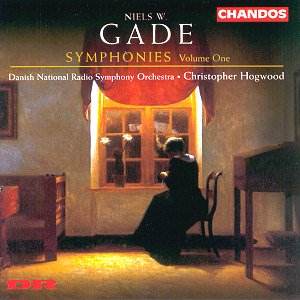Niels GADE
SYMPHONIES Volume 1
Symphony no.2 in E, op.10;
Symphony no.8 in b, op.47;
Allegretto, un poco lento (discarded slow movement from Symphony no.8);
In the Highlands,
op.7.
 Danish National Radio Symphony
Orchestra/Christopher
Hogwood
Danish National Radio Symphony
Orchestra/Christopher
Hogwood
 Chandos CHAN9862 [69'
46"]
Chandos CHAN9862 [69'
46"]
Crotchet

Times are changing in the record world while in the concert hall they have
hardly changed at all. When Neeme Jarvi embarked upon the first complete
cycle of Gade's Symphonies in the mid eighties, no less an expert on Scandinavian
music than Robert Layton had doubts as to whether it was worth while (in
the end he decided it was). And now we have rival cycles. And yet, your chances
of hearing any of these works in the concert hall are about as dim today
as they were before, at least outside Denmark.
The new cycle begins boldly with one of the weakest, the second, which even
Gade himself made little attempt to revive in later years. In fact it is
a likeable piece, recognisably Danish in its sturdy tones, more effective
in its poetic moments (of which there are many) than its assertive ones,
which are rather four-square and short-breathed. Maybe a conductor who allowed
it to unfold a little more patiently would have got more out of it, but Hogwood
is certainly brilliant, and affectionate too when called for. The Jarvi
performance sometimes takes a mite more time, but overall they reach such
similar conclusions over tempo and articulation that you would be hard put
to tell them apart.
The contrast between this amiable but limited piece and the eighth, Gade's
last symphony, is most striking. Here there is a far wider expressive range
and an unmistakable Nordic/bardic tone, integrated in true symphonic fashion.
I began by thinking this piece has claims to be in the general repertoire,
but in the finale Gade becomes short-breathed again and fails to crown his
work satisfactorily. So perhaps there is justice both in the gramophone's
attention to his cause and the concert hall's neglect of it. Hogwood responds
well to the piece, but Gade's years in the wilderness mean that there is
probably no conductor today who, as a result of having lived with this music
and loved it all his life, could conduct it as, say, Kubelik conducted Dvorak.
The remaining pieces are first recordings but add little. The discarded slow
movement from the 8th Symphony shows that Gade was not without
self-criticism, for the value of the work would have been seriously impaired
had this static, repetitive movement remained in place. In the Highlands
has little more than instant bustle to recommend it.
Gade's work was written in a period of symphonic hiatus when the masters,
Mendelssohn and Schumann, who had attempted, and not quite managed, to inherit
Beethoven's mantle were dead, Brahms was still waiting to write his first
symphony and Bruckner was as yet unrecognised. In a world dominated by Raff
and Rubinstein (all of whom had similar problems with their finales) Gade's
star shone bright. (But dare I suggest that few symphonies written in this
symphonic no-man's land have as much life as Sullivan's single work?). For
those who enjoy the hills as well as the mountains of romantic symphonism
he still has much to say. The new series should be worth following, and the
warm recording and helpful notes in three languages can only add to the pleasure.
Christopher Howell


